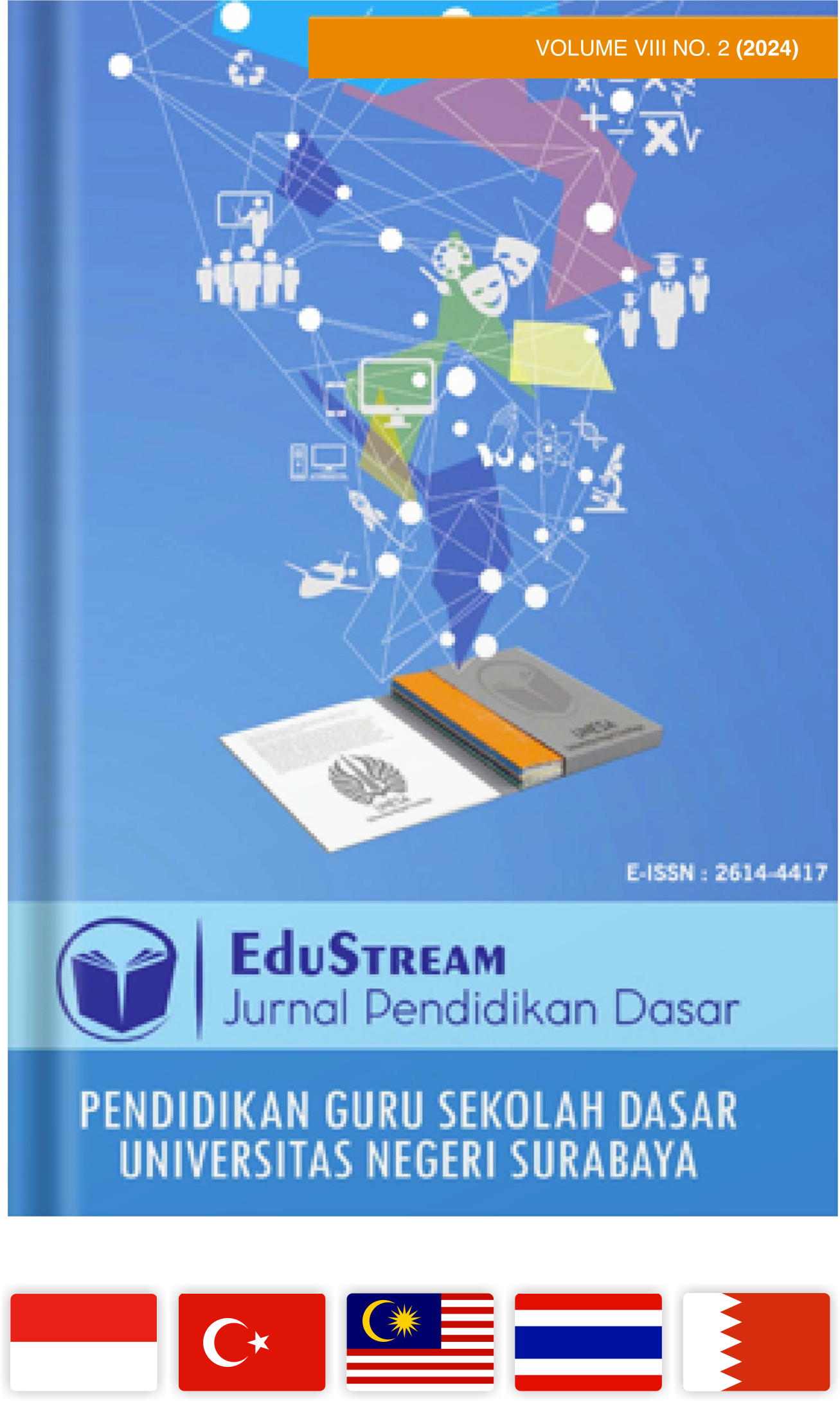Application of Animated Video Learning Media to Enhance Elementary Students' Ability to Understand Intrinsic Elements of Short Stories
DOI:
https://doi.org/10.26740/eds.v8n2.p100-112Keywords:
application of animated video learning media, Indonesian, intrinsic elements of short storiesAbstract
This study aims to examine the improvement in students' ability to understand intrinsic elements of short stories through the application of animation-based video learning media. This study employs the Classroom Action Research (CAR) method, conducted in two cycles with a total of 78 students from three elementary schools. Each cycle involves the stages of planning, action, observation, and reflection. The study results indicate a significant increase in student engagement and comprehension. In the first cycle, 57% of students achieved the Minimum Completeness Criteria (MCC), while in the second cycle, this percentage rose to 89%. The use of animated media has proven effective in enhancing students' learning motivation and their understanding of intrinsic elements of short stories, such as theme, character, and setting. It is suggested that animation-based learning media be used more frequently in literature lessons in elementary schools to boost active participation and student learning outcomes. Additionally, it is recommended that teacher training in designing and implementing animation-based media be improved to ensure optimal application in various schools. Further research is also recommended to test the effectiveness of animated media on other learning materials and to explore its impact on students' critical thinking skills and creativity in various learning contexts.
References
Bandura, A. (1977). Social Learning Theory. New Jersey: Prentice Hall.
Ekanayake, S., et al. (2020). The Importance of Language and Cultural Understanding in Education: Implications for Teaching Literature. International Journal of Humanities and Social Science Research, 10(2), 15-25.
Fredricks, J. A., Blumenfeld, P. C., & Paris, A. H. (2004). School Engagement: Potential of the Concept, State of the Evidence. Review of Educational Research, 74(1), 59-109.
García-Sánchez, J. N., et al. (2019). The Effects of Animated Illustrations on Story Comprehension. International Journal of Instructional Technology and Distance Learning, 16(2), 1-12.
Gardner, H. (1983). Frames of Mind: The Theory of Multiple Intelligences. New York City: Basic Books.
Hanif, M. (2020). The Role of Animated Media in Enhancing Student Engagement and Learning Outcomes. Journal of Educational Technology, 32(4), 23-36.
Ingersoll, R. M. (2003). Who Controls Teachers' Work? Power and Accountability in America's Schools. Cambridge: Harvard University Press.
Jang, S. J., & Tsai, M. F. (2012). Exploring the TPACK of Taiwanese Elementary Mathematics and Science Teachers with Respect to Use of Interactive Whiteboards. Computers & Education, 59(1), 327–338.
Kemmis, S., & McTaggart, R. (1988). The Action Research Planner (3rd ed.). Melbourne: Deakin University Press.
Koh, J. H., & Divaharan, H. (2011). Developing Pre-Service Teachers’ Technology Integration Expertise through the TPACK-Developing Instructional Model. Journal of Educational Computing Research, 44(1), 35–58.
Kotorov, R., et al. (2020). Enhancing Students' Critical Thinking Skills through Literature Education: Strategies and Practices. Journal of Language and Literature, 12(1), 42-55.
Mayer, R. E. (2009). Multimedia Learning (2nd ed.). Cambridge: Cambridge University Press.
Mayer, R. E., & Moreno, R. (2003). Nine Ways to Reduce Cognitive Load in Multimedia Learning. Educational Psychologist, 38(1), 43-52.
Mendez, I., et al. (2022). Effects of Multimedia on Reading Comprehension: A Meta-Analysis. Educational Psychology Review, 34(1), 89-110.
Mills, G. E. (2011). Action Research: A Guide for the Teacher Researcher (4th ed.). London: Pearson.
Murphy, C. A., & Stewart, J. C. (2017). On-Campus Students Taking Online Courses: Factors Associated with Unsuccessful Course Completion. The Internet and Higher Education, 34, 1-9.
Piaget, J. (1976). The Child and Reality: Problems of Genetic Psychology. New York City: Viking Press.
Rone, D., et al. (2023). Investigating the Effectiveness of Varied Teaching Methods in Elementary Literature Education. Journal of Education and Practice, 14(5), 75-84.
Ryan, R. M., & Deci, E. L. (2000). Self-Determination Theory and the Facilitation of Intrinsic Motivation, Social Development, and Well-Being. American Psychologist, 55(1), 68-78.
Schön, D. A. (1983). The Reflective Practitioner: How Professionals Think in Action. Basic Books.
Wang, S., et al. (2016). The Impact of Animation on Students’ Learning Experience: A Review. Educational Technology & Society, 19(1), 35-49.
Wang, S., et al. (2020). The impact of animated videos on students’ learning motivation: A meta-analysis. Educational Technology & Society, 23(2), 83-99.
Wong, M. S., et al. (2021). The Effect of Animation on Students’ Learning Experience: A Review. Educational Technology & Society, 24(2), 95-109.
Zepeda, C., et al. (2019). Effectiveness of Conventional vs. Innovative Teaching Methods in Elementary Education: A Comparative Study. International Journal of Educational Research, 100, 120-134.
Downloads
Published
How to Cite
Issue
Section
License
Copyright (c) 2024 EduStream: Jurnal Pendidikan Dasar

This work is licensed under a Creative Commons Attribution-ShareAlike 4.0 International License.
Authors who publish with this journal agree to the following terms :
The articles published in this journal are protected by copyright. The copyright remains with the authors of the articles, but the publishing license is held by Universitas Negeri Surabaya as the journal manager. This license, Creative Commons Attribution-ShareAlike (CC BY-SA), allows readers to copy, distribute, and adapt the work, provided that proper attribution is given to the original author and any modified work is published under the same license. This license grants the freedom to use the work both commercially and non-commercially, as long as it adheres to the terms outlined in the license.
 Abstract views: 376
,
Abstract views: 376
, PDF Downloads: 611
PDF Downloads: 611

















